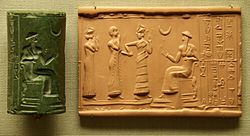Sin (mythology) facts for kids
Quick facts for kids Sīn (Nanna) |
|
|---|---|
| God of the Moon | |

This picture shows an impression from a cylinder seal. It belonged to Ḫašḫamer, who was a governor around 2100 BC. The person sitting is probably King Ur-Nammu. He is giving the governorship to Ḫašḫamer. A protective goddess, Lamma, is leading Ḫašḫamer to the king. Sīn/Nanna, the moon god, is shown as a crescent moon.
|
|
| Planet | Moon |
| Symbol | Bull, Crescent |
| Personal information | |
| Consort | Ningal |
| Children | Shamash, Inanna |
Sīn or Nanna was the important god of the Moon in ancient Mesopotamia. People in lands like Sumer, Akkad, Assyria, and Babylonia worshipped him.
Nanna was his Sumerian name. He was believed to be the son of the gods Enlil and Ninlil. Later, people in other parts of Mesopotamia called him Sīn.
Who Was Sīn/Nanna?
Sīn/Nanna was one of the most important gods in ancient Mesopotamia. He was seen as the god who brought light to the night sky. People believed he controlled the moon's phases.
His main symbols were the crescent moon and the bull. The bull was a symbol of strength and power.
Family of the Moon God
Sīn/Nanna had a family of other important gods. His wife was the goddess Ningal. Together, they had two famous children.
One child was Shamash, the god of the Sun. The other was Inanna, the goddess of love and war. This made Sīn/Nanna a central figure in the gods' families.
Places of Worship
The two main cities where Sīn/Nanna was worshipped were Ur and Harran. Ur was in the southern part of Mesopotamia. Harran was in the north.
In Ur, a huge temple called a ziggurat was built for him. A ziggurat was a large temple tower. People believed it connected the earth to the heavens.

Images for kids
See also
 In Spanish: Sin para niños
In Spanish: Sin para niños




